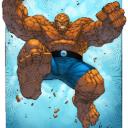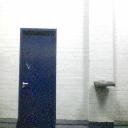Yahoo Answers is shutting down on 4 May 2021 (Eastern Time) and the Yahoo Answers website is now in read-only mode. There will be no changes to other Yahoo properties or services, or your Yahoo account. You can find more information about the Yahoo Answers shutdown and how to download your data on this help page.
Where is the equal and opposite force to W?
My brother used to catch those who understand physics and those who just memorize it with this question.
There is a table. On the table is a chair. On the chair is an object (say a stone) which weighs W kg. The stone has a force R acting on it and it in turn applies a force R on the chair. Similarly the table has four forces acting on its legs which are cancelled by the equal and opposite forces acting from the table, lets call them r.
Now according to Newtons Laws (since there is no motion) there should be an equal and opposite force to W. Where is it?
1 answer... and wrong
The question is simple and stated in the heading. The second answer doesn't answer the question either. There needs to be no confusion. Forget the R's and the r's if it confuses you. I just wanted to show that they each have their equal and opposite forces. Restate the question:
Where is the equal and opposite force to W?
And if that confuses you, don't read the physics section.
8 Answers
- PearlsawmeLv 71 decade agoFavourite answer
Newton’s third law is stated as for very action there is an equal but opposite reaction. This is not the correct form because it does not give the correct concept.
Many fail to understand the real meaning.
The third law states if A exerts a force on B, then B exerts an equal but opposite force on A. It is very important to note that the action force and reaction force do not act on one and the same body. One force acts on A; where as the other acts on B.
The motion of either A or B depends on the net force that act on a single body say A or B.
THE ACTION FORCE AND REACTION FORCE REFERRED IN NEWTON’S THIRD LAW WILL NEVER CANCEL EACH OTHER, BECAUSE THEY DO NOT ACT ON ONE AND THE SAME BODY.
In the example given in this question, let us see what the action and reaction pairs are.
Consider the stone and the chair.
The stone is pulled by the earth downward. The force of pull down ward (weight) on the stone is the action force. The reaction force is the force with which the stone pulls the earth toward it. This force acts on the center of earth and points upward.
These two forces are equal and opposite as per Newton’s third law. They do not act on one and the same object.
If this is the only force that is acting on the stone then the stone must come down. We know it is at rest. We shall see the other forces acting on the stone.
If there was not a chair the stone will fall down. Instead of chair if there were some net, the net will stretch down a little. That is the stone is pushing the net down. Now due to elasticity the net gives an upward force on the stone. The force exerted by stone acts on the net; the reaction force of the net acts on the stone. These two forces are action and reaction. But these two forces do not act on one and the same body. The motion of the stone or the net depends upon the force that acts on them separately. Instead of net, now we shall replace the chair. Here also the elastic property of chair is pushing the stone upward; but it is not as obvious as in the case of net.
Now there are two forces that are acting on the stone; the pull of gravity and the upward force exerted by the chair. These two forces are acting on the stone and they are not the action reaction pair referred by Newton’s third law. The motion of the stone depends upon the resultant of these two forces. In this case since we know that the stone is at rest we conclude that these two forces are equal and opposite; but they need not be equal always. If the stone is heavy enough to break the chair then the downward force is greater than the upward force exerted by the chair.
Similar reasoning will explain about the chair on the table and table on the ground.
- 1 decade ago
I dont understand as to why you confuse the question with R, r, W etc. Let me try to answer the way in which I have understood. Newton's law says that for every action there is an equal and opposite reaction. In your example the stone is exerting a force W on the ground through the table, chair ... The earth is exerting an equal and opposite force on the stone. For a force to get cancelled they should be acting on a same point, whereas here they are acting on two diffent points, one on the ground and the other on the stone. Hence they will not get cancelled at all
- 1 decade ago
The stone, table and chair are all exerting a downwards force according to gravity's action on them. The force of each is equalled by an upwards force from the ground. This is why tables and chairs break... the table may not be disgned to take the additional force presented by the stone AND the chair. For the chair to be equalling the stone's downward force alone it would need to not be in contact with the table... ie floating. The problem with the question is in the algebra, you suppose in naming the tables equal and opposite force as r that it is only referring to the table... but it of course is not... a simple question really
- JiveSlyLv 41 decade ago
This is an easy question. There is a net downward force and net upward force and they cancel each other out.
First of all, if the weight of the stone is W, don't call the downward force exerted by the stone W as well. Maybe call it "w" since it is really equal to (W x g).
So your question is, where is "w"? It is acting on the chair, which is acting on the table which is acting on the ground. That makes the net downward force.
Now, help me with this one: How come in some proteins, the same primary sequence can form either alpha helixes or beta sheets?
- Anonymous1 decade ago
The equal and opposite force is exerted by the chair on the stone. The system is not moving so if you remove the table and chair from the equation and the stone is simply sitting on the ground...The equal and opposite force is exerted by the ground on the stone.
- MikeLv 51 decade ago
the force equal and opposite to W is the normal force of the chair acting on the stone.
- ?Lv 45 years ago
so,gravity(weight)of the book is equal to N,normal force,provided by the table... energy for N comes from the elasticity of the table;if the table was made from paper,maybe it couldn`t resist an breaks...
- 1 decade ago
Obviously the equal and opposite force to W should be M - IF Newton named it anything else, sorry, but he was wrong.




